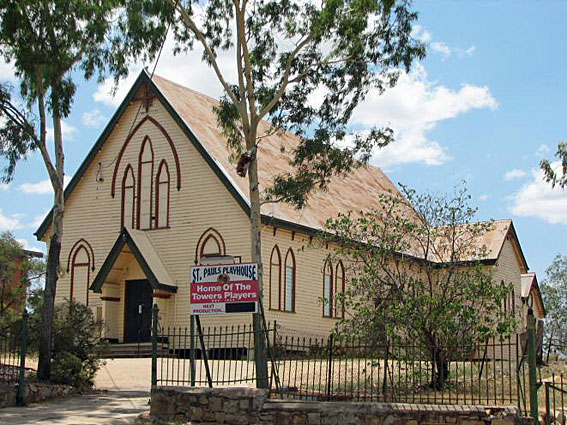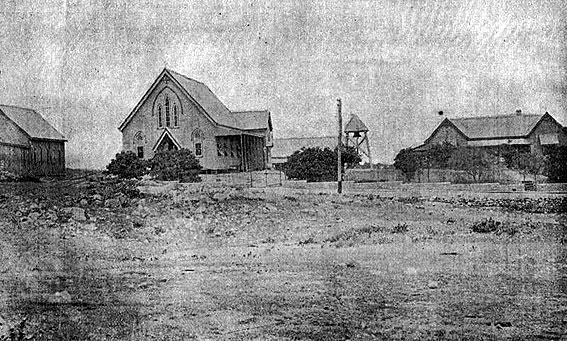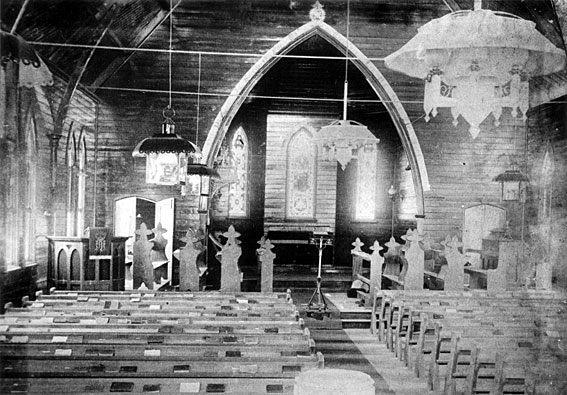
St Paul's Anglican Church, Charters Towers,
now 'St Paul's Playhouse'
[Photograph supplied by Peter Meyer]

St Paul's Anglican Church, Charters Towers,
now 'St Paul's Playhouse'
[Photograph supplied by Peter Meyer]
Historical and Technical Documentation by Geoffrey Cox1
© OHTA 2007, 2014, 2017 (last updated March 2017)
Charters Towers was established as a pastoral district in the 1860s, but it entered a period of enormous growth between 1872 and 1916 when gold mining became the predominant activity. It was during the period of Charters Towers' greatest prosperity that a pipe organ was installed in St Paul's Church of England in 1895.
St Paul's Church was designed in 1883 by the Townsville architect William George Smith, jnr, who won a competition that year for a new Church of England in Charters Towers.2 The church was opened by the Bishop of North Queensland on 30 December 1883. The Anglican congregation moved to new premises in 1965, and the old church has been used as a theatre since 1969.3

The Paul's Church of England, Charters Towers, in 1905
showing the Church Hall (1875), Church (1883) and Rectory
[Photograph: John Oxley Library, State Library of Queensland]

The Interior of St Paul's Church, Charters Towers, c.1890
[Photograph: Charters Towers and Dalrymple Archives Group]
The cultural importance of Charters Towers during its boom period can be gauged by the fact that at least two prominent organists were attracted to work and live in the area. The first was the London-born Samuel G. Benson (1849-1925), who had opened the organ in St James' Anglican Cathedral, Townsville, in 1885. He had moved to Charters Towers by 1887, becoming organist and choirmaster at the Roman Catholic Church and conductor of the Charters Towers Musical Union.4 Benson had moved to Brisbane by early in 1889,5 and his time in Charters Towers did not, therefore, coincide with the arrival of the organ there.
A second notable organist who resided for a time in the region was Guglielmo Enrico Lardelli (1857-1910), a much travelled musician who had arrived in Australia in 1875 at the age of eighteen. He was organist at St Mary's, West Maitland (1881-85), and later at St Mary's, Waverley, NSW (c.1887-94), Christ Church Cathedral, Grafton (1901), St Stephen's Presbyterian Church, Bathurst (1902-03) and Wesley Church, Perth (1903-06). He moved to North Queensland in 1908 for health reasons, and died in Charters Towers in 1910 at the age of 55.6
There were still recollections amongst the members of the Whitehouse firm in Brisbane as late as the early 1970s that an organ had once existed in Charters Towers, but it seemed that it had disappeared long since.7 Details of the instrument have emerged from the 1980s onwards, largely through the research of Graeme Rushworth and Peter Meyer respectively.
Efforts to procure an organ for St Paul's in Charters Towers can be traced back at least to 1881, even before the church itself was built. A concert in aid of St Paul's Organ Fund was held at the School of Arts in June that year:
That the proper time to make hay is while the sun shines seems to have been fully understood by the promoters of the organ fund in connection with the Anglican Church at Charters Towers, and they harvested a wonderful crop. The week before last the show of the local agricultural, pastoral, and mining association, was held, and shoals of visitors were in town. Our correspondent, writing on the 15th instant, states: —"On Thursday night last a concert in aid of St. Paul's Organ Fund was held at the School of Arts. The time was well chosen, every person being in good humour for entertainment after the show. The hall was over-crowded, many persons being unable to obtain admission. The concert was in every way, but best of all financially, a great success. The amount realised, I am informed, exceeded £100, which is far and away more than was ever before taken for one night's entertainment at the School of Arts."8
It was not until 1895 that an organ was purchased. In January that year, Fincham & Hobday of Melbourne wrote to the Revd F. Barton Parkes, giving him the specification for an organ of nine speaking stops and three couplers, priced at £255.9 Fincham's offer was apparently rejected, for Parkes managed instead to purchase an instrument from Goulburn, NSW, in April 1895 for a mere £20. It had earlier been installed in St Philip's Anglican Church, Church Hill, Sydney, in 1856, having reportedly been built in 1849 and imported second-hand.10
The instrument proved inadequate for St Philip's, and it was sold in January 1875 for £100 to Mr A.M. Betts of Goulburn, where it was erected in the new St Saviour's schoolroom, which served as the Anglican pro-Cathedral. In Goulburn, the organ was placed initially in a gallery, but it was moved to the north-east of the nave in 1879. Maintenance and repairs costing £60 were undertaken at this time by Mr McLean, a local craftsman who had worked with J.W. Walker & Sons in London.11
But the instrument continued to prove inadequate. Contemporary reports stated that it had been 'condemned by a practical man on its first arrival in Sydney years ago'. The case front was described as having 'three coronetted towers of handsome pipes.'12 No photograph of the organ appears to have survived, and the only contemporary photograph of the interior of St Paul's Church (above) dates from before the organ was installed.
After arrival in Charters Towers, The Northern Miner reported that the organ was to be dedicated by the Bishop of North Queensland on Sunday 28 July 1895, when it would first be heard in public services. The paper also reported that an organ recital would 'probably be given [on] the succeeding Monday, with the [help] of the Apollo Orchestra.' The specification, described as comprising 'fourteen speaking stops,' was given as follows:
| GREAT ORGAN Clarionet Dulciana Twelfth Fifteenth Principal Open Diapason Double diapason Bass Flute Stop diapason SWELL ORGAN [Lieblich] Gedakt Oboe (reed) Principal Open diapason bass PEDAL ORGAN Bourdon COUPLERS Swell [to] Great [Swell to] Pedals Great [to] Pedals |
metal metal metal metal metal metal metal and wood metal metal wood metal metal metal and wood wood |
8 ft tone 8 ft tone 3 ft tone 2 ft tone 4 ft tone 8 ft tone 16 ft tone 4 ft tone [8*] ft tone 4 ft tone 8 ft tone 4 ft tone 8 ft tone 16 ft tone |
CC to G, 56 pipes. CC to G, 56 pipes. CC to G, 56 pipes. CC to G, 56 pipes. CC to G, 56 pipes. CC to G, 56 pipes. CC to G, 56 pipes. CC to G, 56 pipes. CC to G, 56 pipes. [* given as 16ft in the source] CC to G, 56 pipes. CC to G, 56 pipes. CC to G, 56 pipes. CC to G, 56 pipes. CC to G, 30 pipes. |
3 Composition Pedals.13
The order of the stops and other aspects of the specification suggest that it contains inaccuracies, including the pitch of the 'Stop diapason,' which should presumably be 8ft rather than 16ft. The Clarionet stop on the Great may have replaced a former stop. The presence of a 16ft stop on the manuals seems unusual for an English organ of the period, and the designation 'Bass' on the so-called 'Double diapason Bass' suggests that this may simply have been a common bass octave (at 8ft pitch, and of shorter compass) for all of the 8ft flue stops on the Great, which often extended only to Tenor C (42 notes in this instance). It is also possible that the [Lieblich] Gedakt on the Swell was at 8ft pitch. It has been suggested that the Great and Swell compass may have been increased in Goulburn,14 although this seems less likely, given the cost of repairs at the time. The Pedal compass, given here as 'CC to G, 30 pipes' is also obviously inaccurate, and it is significant that George Fincham, in discussing the possible replacement of the organ in 1898, described it as having 'short compass pedals.'15 The following description of the organ accompanied the specification in 1895:
The case is very handsome, the front being of handsomely carved cedar in three bays, with a heavy handsome cornice. The console is of polished cedar, with dark English oak fittings, the pedals being of hardwood. The three bays of the front case are filled with ornamental speaking pipes colored dark chocolate below the lip, and a light buff color above, with bands of gold and gold fleur de lis upon the color. We congratulate St. Paul's people upon this great acquisition to their church, and with Mr. Arthur King in charge of the choir we expect to chronicle many things of an advanced character.16
In the event, the dedication and opening recital were postponed for a week, and the organ was first heard in two services on Sunday 4 August, with the recital taking place on the following evening.17 A full report of the organ recital appeared as follows:
FIRST ORGAN RECITAL
The first organ recital in connection with the opening of the pipe organ attracted so large an audience to St. Paul's Church on Monday evening that accommodation could not be found for members, even with every available space requisitioned for seating and standing. The programme opened with the singing of the Old Hundredth hymn in which all joined. A strong orchestra of twenty-five instruments, including the organ, at which Mr. Richards, of Townsville, presided, and under the conductorship of Mr. King, then played "The Heavens are Telling" (Haydn) with excellent effect, a veritable treat to lovers of instrumental music. The organ solo "O Sanctissima" (F. Lux) is a series of interesting and effective variations composed on the air, the Sicilian Mariners' Hymn. Although the piece culminates with the loud tones of the instrument in the last variation, the composer has preferred to end with a short repetition of the theme played upon a single register of the softest tone. Mr. Richard's execution was that of the artist, and as full rich tones filled the building the grandeur of the instrument was brought home to the large audience. Mrs Pollard's rendering of "Seraph Songs" (Fauré), with organ and violin obligato (violins Miss Shaw and Mr. C. A. Pollard) was a delightful effort by that gifted singer, and but that the Vicar had specially requested that there be no demonstration must have met a storm of applause. The powerful orchestra was again heard to best effect in the "Intermezzo" (Mascagni), the blending being particularly fine in this number. Both Mr. Bolland and Mr. Clatworthy, who were down on the programme for numbers were absent through indisposition, and the blank was in measure filled by Mr. Richards playing "The Festal March." The organ solo "Cantilene Pastorale" (Jules Grison) is a characteristic piece and affords many opportunities of clearly hearing the flutes and other soft solo stops; an episode in the tonic major contrasting effectively with the principal theme gives an additional charm to this fine movement. The solo "Inflammatus" (Rossini) followed by Miss Olsen, but the singer's voice lacked the power to fill so large and packed a building. Then came the anthem, "What are These" (Stainer) by the choir, who showed careful training in the parts and produced a pleasing choral number. The gem to music lovers was undoubtedly the duet "I waited for the Lord" from Mendelssohn's "Hymn of Praise" sung by Mrs. Pollard and Miss Olsen, to the accompaniment of the organ. It is very long since anything so sweet has been heard here, and was in itself an evening's entertainment. The organ solo "Marche Nuptiale" in E (Op 25) (A. Guilmant) made a brilliant conclusion to the bright and perfectly carried out programme.18
Mr Bolland and Mr Clatworthy, who are both mentioned in this account as being 'indisposed' and unable to perform, were presumably local organists, as they had been listed to perform organ solos when the programme was advertised.19
After such an auspicious opening in Charters Towers, it was not long before difficulties were experienced. By February 1898, indeed, the Rev. J. Pike of St Paul's, Charters Towers, was in receipt of a specification and proposal for a completely new organ from George Fincham of Melbourne at a cost of £400.20 The old instrument appears to have fallen into a further state of disrepair, and in 1911 it was dismantled and partially repaired by an unnamed contractor who did not complete the work. B.B. Whitehouse & Co. of Brisbane were approached in August 1912 to complete the repairs, but declined on the basis that they were too busy. The organ was reportedly stored beneath the church at this time, and it remains unclear whether or not it was ever re-assembled.21
It seems most likely that the organ was left until it was beyond repair, and was probably broken up some years later. The original builder of the instrument remains unknown, and the strange circumstances of its being imported second-hand only seven years after it had been built remain a mystery.
The present author conjectured in 2007 that some of the pipework may have found its way into the organ at the Methodist Church, Cairns, where Noel Furguson added three ranks of 42-note compass around 1956. It was simularly conjectured that some of the pipework may have found its way into the residence organ of Noel Ferguson's in Cairns in 1951.22 But neither of these conjectures can be supported by hard evidence.
____________________________________________________________
1 An earlier version of the historical documentation presented here appeared in 2007 as: Geoffrey Cox, 'Lost in Far North Queensland: A Case of Two Disappearances,' OHTA News, vol. 31, no. 3 (July 2007), pp. 12-18.
2 Donald Watson & Judith McKay, Queensland Architects of the 19th Century: A Biographical Dictionary (Brisbane: Queensland Museum, 1994), p. 165.
3 Towers Players: Charters Towers Local Theatre Group http://www.towersplayers.websyte.com.au/site.cfm?/towersplayers/8/
- accessed November 2011.
4 F.D., 'Men we Meet: Mr. S.G. Benson,' The Queenslander (27 February 1897), p. 465.
5 Euterpe, 'Musical Echoes,' The Queenslander (30 March 1889), p. 600.
6 Richard Ward, 'Lardelli: The Changing Fortunes of a Wandering Signor,' The Sydney Organ Journal, vol. 45, no. 4 (Spring 2014), pp. 23-29; Peter Meyer, 'Church Music on Church Hill: A Study in the Transmission of Culture,' The Sydney Organ Journal, vol. 38, no. 2 (Autumn 2007), p. 39.
7 Personal communication to G. Cox from Mr J.H. Whitehouse, c.1974.
8 The Queenslander (2 July 1881), p. 8.
9 George Fincham Letter Book 15, pp. 118-121.
10 Graeme Rushworth, Historic Organs of New South Wales: The Instruments, Their Makers and Players 1791-1940 (Sydney: Hale & Iremonger, 1988), p. 22; The Northern Miner (18 April 1895), p. 2, supplied by courtesy of Graeme Rushworth.
11 Meyer, op. cit., pp. 38-39.
12 Cited in Rushworth, op. cit., p. 426.
13 The Northern Miner (22 July 1895), p. 4, cited by Graeme Rushworth.
14 Meyer, op. cit., p. 39.
15 George Fincham Letter Book 11, pp. 425-26 (13 July 1898).
16 The Northern Miner (22 July 1895), op. cit.
17 The Northern Miner (27 July 1895), p. 2; (3 August 1895), pp. 1, 2; (5 August 1895), p. 2; (6 August 1895), p. 3, cited by Graeme Rushworth.
18 The Northern Miner (6 August 1895), op. cit.
19 The Northern Miner (5 August 1895), op. cit.
20 George Fincham Letter Book 11, pp. 338-40; subsequent correspondence in George Fincham Letter Book 11, pp. 369, 378, 425-26, 454-55, & George Fincham Letter Book 12, pp. 268.
21 Correspondence between St Paul's, Charters Towers, and B.B. Whitehouse & Co. (Archives of the Anglican Diocese of North Queensland), cited in Meyer, op. cit., p. 39.
22 Cox, op. cit.